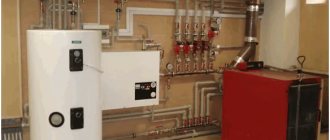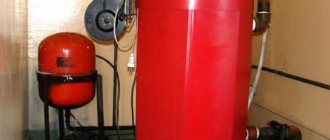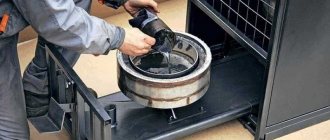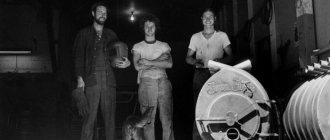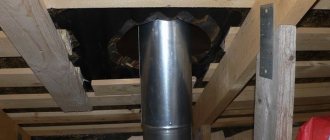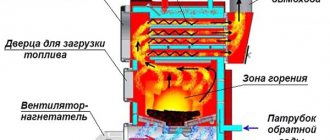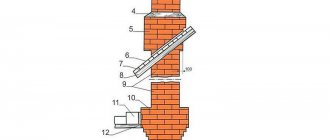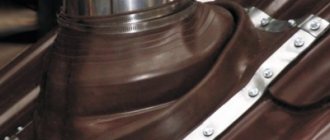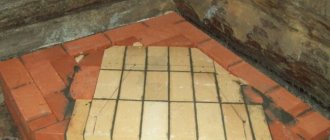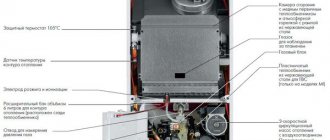What is used oil?
Refining is an oil-based product that is obtained during long-term operation of a car engine. Under the influence of external factors, the oil loses its normal characteristics and becomes unsuitable for further use. The mass of the product contains a whole complex of various particles formed during the operation of metal parts of mechanisms.
The used oil must be drained and replaced with new oil. When replacing, it is recommended to dispose of the waste at special collection points, where it finds its useful use in the form of fuel for heating the room.
How does an exhaust boiler work?
From the fuel tank, using an axial oil pump, waste oil is pumped through an oil-resistant hose into a forced evaporation chamber.
This chamber is welded from a thick metal pipe (wall thickness - 3-5 mm), since a working environment with a temperature of up to 400°C is created inside it.
[ad1]The waste evaporates at the bottom of the evaporation chamber, and the resulting steam enters the common combustion chamber.
All systems that use used oil must have oil preheating to ensure accurate temperature and reliable ignition.
Intelligent automatic systems preheat the oil in front of the injector block (burners), so fuel temperature control is more accurate, combustion is more reliable and performance is also better.
In the center of the combustion chamber there is a pipe that delivers a fresh stream of air, pumped using a special fan.
The evaporation of used oil, enriched with a portion of oxygen, burns completely. During the combustion process, the coolant in the pipeline is heated.
It is advisable to clean used oil from mechanical impurities before using it as fuel, at least using a coarse filter.
This measure will increase the efficiency of waste combustion and ensure longer operation of the burner and combustion chamber.
Therefore, when installing a heating boiler using waste oil, it is necessary to equip it with a cleaning filter in advance.
If you have the opportunity to connect to a gas main, then the ideal option would be a gas generator furnace. Very effective due to its design.
And if you need hot water supply, then this is your place. One of the most economical heating devices.
Production of a boiler for development
Almost anyone can make a working boiler. There are many designs and methods, all of them have been tested in practice and are widely used. There are two main designs, let's look at them.
Drawings of heating units
In the first case, the boiler consists of two chambers connected to each other by a pipe with holes. The evaporation compartment is located in the lower chamber, where open combustion of the waste occurs. Afterburning occurs in a pipe with holes into which air is supplied naturally. After the pipe there is a second chamber, in which the speed of movement of fuel vapors decreases.
The partition in the upper compartment also serves for complete oxidation and connection with nitrogen. A chimney is installed higher, it serves to remove combustion products and additional draft. Light the boiler using a rag soaked in gasoline or kerosene. In the lower compartment there is a special damper that regulates the air supply to the first combustion chamber. For hot water supply and heating systems, a water jacket is installed in the second compartment. It is important to leave a gap between the pipe and the tank of at least 70 mm.
The second manufacturing method involves more economical use of fuel.
The power of the device can reach 15 kW.
The design contains a turbine for forced air supply. Increased boost burns the fuel mixture more efficiently. The waste tank is taken out separately and a valve is installed on it to regulate the oil supply to the boiler or stop it completely. As in the first case, the central pipe is equipped with slots or holes for efficient combustion of fuel vapors. The waste combustion products are also removed through the chimney; when installing it, sharp corners and sharp turns should not be allowed. Recommended length is at least 4 m.
This design allows you to comply with all safety requirements, and also makes it possible to easily install water elements of the heating system. The most economical.
Necessary materials
When making a waste oil boiler, the following materials may be needed:
- Gas cylinder with a volume of at least 50 l
- Metal pipes with diameters of 100 mm, thickness of 3 mm and 6 mm
- Metal sheets from 3 mm to 5 mm thick
- Car brake disc
- Steel pipe with a diameter of 15 mm
- Fireproof Fuel Supply Hose
- Ball valve
- Oil tank
- Steel cover, at least 5 mm thick
- Steel sheet no thinner than 3 mm, for water jacket
- Set of pipes for connections
It is recommended to use special products to protect against rust; this will extend the life of the boiler. In places where pipes are connected, paste and tow are used to increase sealing.
Tools used for manufacturing
During work you may need a variety of tools:
- For welding connections, transformer machines or inverters are used, since such connections are subject to increased requirements.
- Drill kit and hand electric drill to make holes for mounting and torch.
- Set of pipe thread dies.
- Grinding machine, two wheels for it: cutting and cleaning.
- Tape measure, metal ruler, gas wrench and device for marking on metal.
Before starting work, it is recommended to secure the welding site, and also use coolant when drilling.
Instructions for making a boiler for testing yourself
In order to make a waste oil boiler with your own hands, you must follow the following instructions:
- The gas cylinder must first be emptied. The valve is turned off from above, the container is turned over and all the contents are drained. The cylinder is washed with water, only then can welding and cutting work be carried out.
- Two openings are cut out in the container, leaving a strip of at least 50 mm between them. The upper compartment is made larger so that firewood can be loaded into it. The cut parts are not thrown away; these will be hatches for loading fuel.
- Hinges are welded to openings and hatches.
- A ring equal to the inner diameter of the cylinder is cut out of a sheet of steel 4 mm thick, and a hole is made in it slightly larger than the diameter of the burner (100 mm). Serves as a partition between the combustion compartment and the heat exchanger.
- Cut a piece 200 mm long from the steel pipe, make holes on the entire surface for a length of 95 mm.
- The burner blank is inserted into the previously made ring up to the holes and welded.
- The partition is installed at the level of the upper combustion compartment.
- A brake disc from a passenger car can serve as a blank for the evaporator. It is first necessary to close all the technological holes from the bottom and top; for this, two rings are cut out of a sheet of steel, one will be the bottom, and the other will be the lid. Then they are welded, a hole is made in the cover for subsequent installation of the coupling.
- A 150 mm long section is cut from the pipe, then you need to cut it lengthwise and slightly move the walls apart to 3-4 mm. Afterwards, the workpiece is welded to the combustion bowl and attached to the burner.
- A water jacket is formed from a steel sheet around the boiler, and everything should be scalded with a continuous seam.
- Pipes for draining and supplying water are installed at the bottom and top.
- Mount the chimney in the lid and install it on the boiler.
- A hole is made in the wall of the gas cylinder, a tube is inserted into it at an angle, its end is placed above the fuel supply window. After adjusting the extension length, the tube is scalded.
- A thread is cut on the mining supply pipe and a tap connected to the barrel is installed.
How to make a boiler for mining with your own hands
To make a homemade waste oil boiler, you need to use a gas cylinder and cut off the rounded parts to a size of 1 meter in height.
Photo: rpgrant.com.ua
You will also need:
- sheet stainless steel 1.5-3 mm or black steel from 4 mm for the manufacture of the combustion chamber and flame bowl;
- tube for feeding waste made of stainless steel;
- flame tubes with a wall thickness of 3.5 mm;
- a metal strip 40x4 mm and an asbestos cord for sealing the lid;
- 3 mm metal sheet for inspection hatch;
- For the heat exchanger, choose steel from 4 mm.
When all materials are available, you can begin the manufacturing process:
- First, the heat exchanger is welded. For this, flame tubes with a diameter of 32 mm are cut.
- Connect the pipes to the heat exchanger.
- Holes for inspection and the chimney are cut in the second cylinder. Next, a fitting with a diameter of 114 mm is welded, and a neck with a lid is made.
- Both containers are welded into a single body. There should be a steel strip on top for compaction, and the cracks should be filled with asbestos cord.
- An afterburner is made according to the drawing. In the cut end of the cylinder, inspection holes and mounting holes are made for installing the afterburner.
- There should be handles on the lid. The afterburner pipe can be welded or hermetically bolted.
The bottom of the structure is closed with a lid with holes. An oil line is located in the center. Next, the flame bowl is made. After the homemade boiler is assembled, an elbow is welded to the afterburner and a fan is installed. It is recommended to insulate the boiler with non-flammable mineral wool.
Advantages of heating boilers during testing
Heating boilers using waste oil have many advantages.
Economical
The boiler operates on primary waste oil. A properly configured device burns it completely .
More often, such devices are purchased by people who have access to fuel in unlimited quantities.
For example, workers at depots or engineering plants. But even if you have to buy used liquid, you will still be in the black.
The cost of oil is minimal, and it is consumed economically. The oil burns out completely, which means every penny spent on it will be spent.
Autonomy
Such a boiler operates autonomously, without connection to a stationary heating system . The buyer independently, regardless of the centralized supply of heat, decides where the device will be installed. This is relevant in private homes, where autonomous heating is extremely necessary in the cold season.
Simplicity of the device
The device is so easy to assemble and operate that some craftsmen are attempting to assemble it themselves. The operating principle of a homemade and purchased unit is similar, and the resources spent on manufacturing or purchasing are almost the same.
Affordability
It is no coincidence that such heating devices are extremely popular. Despite the fact that there are few manufacturers of such devices on the market, they do not inflate the cost, since they understand perfectly well that such a device can be assembled at home. Combined with the low price of fuel, the consumer can recoup their purchase within the first heating season.
Photo 1. Two boilers (yellow and red) running on waste oil. Manufacturer: Thermobile.
Wide range of applications
Waste oil boilers are used not only for heating residential premises. They can often be found in offices, institutions, and even industrial and warehouse areas. It is these factors that have influenced the fact that such devices have received a wide range of applications.
Environmental friendliness
The fuel burns completely. At the same time, no toxic waste or harmful substances are released into the surrounding atmosphere. The operation of the device is absolutely harmless to people and the environment. Many manufacturers' models are marked with environmental safety marks from various environmental organizations.
Efficiency of use
The device quickly heats the air and the room around it and maintains the set temperature. Warmth is felt almost immediately after turning on the device.
It not only remains in the room and does not disappear over time, but also spreads to other rooms.
Popular models
Universal burners Belamos 50
Waste oil burners Omni 22.4 - 146.5
Universal waste oil burner EnergyLogic 140
Waste oil burners: all models
Misconception:
Equipment using waste oil is more expensive than equipment using diesel.
Reality:
This is not true. Although mining equipment has a higher cost, heating at mining is much cheaper to operate due to the low cost of fuel. By the end of the first year of operation, the cost of the boiler and the fuel consumed during exhaust operation will be equal to the cost of a boiler using diesel fuel + fuel, and with further operation you will receive significant savings. In addition, exhaust burners, as a rule, are universal, i.e. They work on both OM and diesel.
Misconception:
Due to its complexity and the specific nature of burning waste oil, the equipment is less reliable than diesel equipment.
Reality:
the reliability coefficient of OM equipment is higher than that of diesel equipment due to the higher requirements placed on OM units. Any equipment often fails due to improper operation and negligence.
Misconception:
equipment using waste oil requires constant maintenance (cleaning, adjustment).
Reality:
if the equipment is installed correctly (tank, fuel line, chimney), then the OM burner requires maintenance no more than once a year, similar to any heating equipment. But, as with any heating equipment, fuel contamination has a great influence on the frequency of maintenance.
Misconception:
Since the equipment is not as widespread on the market as diesel, there is a problem with spare parts and service.
Reality:
Of course, it is important to make sure that the equipment manufacturer has a representative office and service center in your city.
Heater design and drawings
Craftsmen engaged in the manufacture of waste oil boilers use in practice 3 methods of burning waste:
- surface combustion with pyrolysis afterburning in a perforated pipe and secondary chamber;
- the use of Babington burners and other homemade structures;
- combustion in a flame bowl, fuel supply is organized by the drip method, air is forced.
Methods of burning waste oils in homemade heaters - pyrolysis combustion, flame bowl, Babington burner device
The first option is implemented in the famous garage stove, consisting of 2 chambers connected by a vertical perforated pipe. We described the second method in detail in the corresponding publication - a Babington burner is made and built inside the body of a steel boiler that previously operated on wood.
We propose to focus on the third option - a dropper stove, converting it into a double-turn (the correct name is two-pass) water boiler. The drawing below shows the basic version of this stove, made from a Ø219 mm pipe. Why it is recommended for beginners to take the drip principle of operation of the heating unit as a basis:
- The design of oil burners is quite complex. Assembly requires some experience and financial investment (for example, for Babington you will have to buy a compressor).
- Surface combustion heaters are fire hazardous (they shoot out flames when water gets into the fuel). Equipping a miracle stove with a water jacket is not an easy task.
- Fuel consumption during surface combustion is prohibitively high - up to 2 liters of waste per hour.
- According to reviews on the forums, the drippers are reliable and can work without automation (however, the owner will have to devote some time to the boiler to get used to manual control). The unit is relatively simple to manufacture.
Dripper stove - a prototype of a two-pass hot water boiler for burning liquid fuels
Note. We discussed in detail how to make a drip stove using waste oil yourself in a separate step-by-step instruction. If you are interested in other types of homemade liquid fuel heaters, go to the authoritative thematic forum termoportal.ru.
Liquid fuel boiler diagram
The dropper diagram shown in the drawing needs to be redone, since together with the fire tube heat exchanger the structure will not fit inside the gas cylinder - you will have to look for a large pipe with a diameter of 400 mm. The dimensions of the heat generator can be reduced without loss of power (15-20 kW) as follows:
- make an afterburner from a DN40 pipe, changing the number and diameter of the holes (more precisely indicated in the drawing);
- for the combustion chamber, take a DN150 pipe;
- weld a water jacket from two propane gas cylinders;
- heat exchanger – at least 8 flame tubes Ø32 mm;
- bowl size - according to the combustion chamber (DN150);
- height from the edge of the afterburner to the bottom of the bowl is 6.5-7 cm.
Popular models
Water heating boiler using waste oil Buderus GE315/105
Fire tube hot water boilers Belamos 350
Waste oil hot water boiler Clean Burn 200-CTB-R-MP
Waste oil boilers: all models
Misconception:
When used oil is used as fuel, the amount of harmful emissions into the atmosphere increases.
Reality:
remember a truck or bus driving in front of you with a smoky diesel engine and a foreign car with a modern diesel engine overtaking you. Indeed, some modern imported burners and boilers and air heaters specially designed for them completely burn fuel, do not smoke, and are environmentally friendly. Burning OM in modern heating systems is even more environmentally friendly than gas, coal, diesel, etc.
Misconception:
In the fight for environmental cleanliness, used oil must be recycled and not burned.
Reality:
if you examine in detail the entire chain of processing and regeneration of used oils, you can come to an unexpected conclusion: emissions from burning OM in special equipment (boilers and air heaters with forced-air burners) are significantly less than the amount of harmful substances when processing OM. In the process of mechanical and chemical purification of OM, many different toxic compounds are used and formed, which are subject to special burial or high-temperature oxidation (i.e., the same combustion). Also, when cleaning and processing oils, huge energy resources are consumed (heating during oil sublimation (cracking), centrifugation, filtration, pumping, transportation, etc.). Thus, as a rule, in the absence of selective collection (each type of oil is collected in a separate container), it is economically and environmentally more profitable to use it locally as fuel in special boilers and air heaters.
Misconception:
operation of a boiler or air heater using waste oil is subject to licensing.
Reality:
the operation of a boiler or air heater does not require licensing or special permits in the same way as for any equipment operating on liquid fuel.
Misconception:
What should I do if I run out of used oil, because the equipment will then stop?
Reality:
everything can run out or shut down: gas, coal, firewood, diesel, fuel oil, electricity. A huge advantage of modern OM burners is that they also operate on diesel fuel without special adjustments. In the event of interruptions in the supply of OM, diesel and/or a mixture of it and waste can be used as fuel.
Rating of the best models
When traditional heaters are not available, waste boilers become the most profitable and simple way out of a difficult situation. Considering that the equipment can operate on all types of liquid flammable materials, including animal fat and diesel fuel, it can be called ideal for emergency situations. By the way, to switch from one type of fuel to another, you just need to adjust the speed and volume of air required for combustion, which takes about 5 seconds.
| Category | Name | price, rub. |
| The best waste oil boilers made in Russia | GeKKON 50 | 108000 |
| Teplamos NT-100 | 268000 | |
| EcoBoil-30/36 | 460000 | |
| The best waste oil boilers made in Europe | Ecoheat 60 S | 280000 |
| Danvex B-60 | 290000 |
What is a waste oil boiler?
Exhaust boilers with a water circuit are very popular. This is due to the low price and availability of fuel, as well as energy independence. If the equipment operates correctly, the oil burns completely without releasing toxins into the atmosphere. The design does not have a large number of components, which has a positive effect on long service life and reliability.
Warming up happens quickly. For waste boilers, the use of different types of waste oils is allowed. But, given the presence of impurities, you should install a filter on the fuel supply system and change it periodically. You should know that complete combustion of oil in this type of equipment helps to avoid costly disposal and release into the environment.
The best waste oil boilers made in Russia
Russian waste oil boilers are produced mainly in Voronezh. Today there are 10 more small enterprises engaged in the development and production of equipment according to their own engineering designs. However, not everyone has a state certificate for the production of heating equipment. When purchasing, it is imperative to read the documents, which guarantees safe operation.
GeKKON 50
A domestically produced pyrolysis boiler that can operate on crude oil, all grades of fuel oil, oils, fats, diesel fuel, kerosene, etc.
GeKKON 50
Specifications:
- Operating voltage – 220 V.
- Maximum temperature in the boiler – 95°C
- Dimensions – 460x660x950 mm
- Weight – 160 kg
- Fuel consumption - 2-5 l/hour
- Power consumption – 100 W.
The main advantage of this model is that almost all types of liquid hydrocarbons can be used as fuel. In addition, the unit is not critical to the viscosity and quality of the fuel; it does not require pre-filtration and heating.
In addition, there are several more advantages of the model - high efficiency, small dimensions, ease of maintenance and repair, reliability of all components and assemblies.
The average cost of the unit is 108,000 rubles.
Teplamos NT-100
A domestically produced boiler, which is designed for heating various industrial premises. The model is fully equipped and ready for launch. Double-circuit - used not only for heating, but also to provide hot water supply in the house.
Teplamos NT-100
Specifications:
- Dimensions – 1140x750x1180 mm
- Weight – 257 kg
- Maximum heating temperature of the coolant – 95°C
- Maximum thermal power - 99 kW
- Fuel consumption – 6 liters per hour
- Compressed air pressure – 0.8 – 1.0 bar
- Chimney diameter – 200 mm
The presence of a control panel allows you to control the equipment automatically. It includes a switch, thermostat, thermohydrometer, emergency thermostat.
A big plus of this model is the excellent thermal insulation of the boiler body made of high-density glass wool. All external elements of the case are powder coated to protect against corrosion.
The boiler has a door for maintenance of the combustion chamber, without the need to dismantle the burner.
The average cost of the device is 268,000 rubles.
Operating instructions Teplamos NT-100
EcoBoil-30/36
Single-circuit boiler designed to heat a room up to 300 square meters. meters for any purpose - residential buildings, industrial facilities.
EcoBoil-30/36
Specifications:
- Dimensions – 580x600x1100 mm
- Chimney diameter – 108 mm
- Water circuit volume – 38 l
- Boiler power – 28 kW
- Fuel consumption - 0.9-1.6 l/hour
The boiler can operate on waste oil, various vegetable oils, kerosene and automatic transmission oils.
The average price for this unit is 460,000 rubles.
Operating instructions "EcoBoil-30/36"
Do-it-yourself installation of a waste oil boiler chimney
Before starting construction of the chimney, it is necessary to decide on the materials, volume, and height. To do this, you need to carry out an individual calculation, taking into account heating equipment, individual characteristics of the house, etc. This article presents only basic tips and recommendations. Clearer numbers need to be discussed individually with the manufacturer of your particular boiler.
To ensure good draft it is necessary that the chimney must be installed in compliance with all norms and regulations (clause 5.1.1.VDPO).
- A separate chimney must be installed for each boiler and heater (clause 3.70.SNiP-91). You cannot connect more than one boiler to one chimney.
- The diameter of the chimney must be no less than the outlet of the boiler or heater pipe (3.71.SNiP-91).
- The thickness of metal pipes must be at least 0.5 mm. They must be made of alloyed special steel with increased corrosion resistance (GOST).
- The boiler chimney should not have more than 3 turns. The radius of curvature of the turn cannot be less than the diameter of the pipe - (4.2.17.VDPO).
- The height of the chimney should not be less than 5 meters (clause 3.73.SNiP-91), which provides the smoke channel with good draft.
- The boiler chimney must be higher than the roof (clause 3.73.SNiP-91): up to 50 cm, with a flat roof,
- up to 50 cm above the parapet or roof, if the pipes are located less than 1.5 m to the parapet or ridge;
- not less than the axis of the ridge or parapet, if the chimney is located 1.5 - 3 meters from the parapet or ridge.
Today, there are a large number of various modular exhaust systems on the market. In them, each element overlaps the other, as a result of which any gaps are reduced to nothing. The joints are treated with a special heat-resistant sealant.
The upper part of the chimney must be equipped with a special canopy to prevent water from entering the heating system through the chimney. The biggest risk is the chimney becoming clogged with debris. The canopy should not allow any large objects into the pipe.
Answers to frequently asked questions:
Question : Is it possible to connect two boilers to one chimney? Answer : It is strictly not recommended to do this. The fact is that the pipe may simply not withstand such a load. The capacity of the chimney is limited. If it is not possible to remove all the smoke, carbon monoxide will enter the room, and this in turn will lead to poisoning of everyone in the room. In addition, there is an official ban from fire services on connections in this way in all industrial premises.
Question : Is a chimney absolutely necessary, or can I get away with a simple hole from the boiler to the street? Answer : Without a chimney, the boiler will not function normally. He will choke. In addition, this has an extremely negative impact on safety.
- User's blog 5energy
- Login or register to post comments
The best waste oil boilers made in Europe
Waste oil boilers are produced both in Russia and abroad. Oddly enough, the most popular are domestically produced boilers and those from Finland. Domestic boilers are the most reliable, and those from Finland are the most economical
Ecoheat 60 S
This boiler model, operating on waste oil, can be used to heat various premises - warehouses, hangars, car service centers and other production areas.
Ecoheat 60 S
The unit is equipped with a burner, delivered fully assembled, ready for use. It can be connected to a separate boiler to obtain water.
Specifications:
- Dimensions – 1020x670x790 mm
- Weight – 243 kg
- Tank volume – 100 l
- Fuel consumption – 5.4 l. at one o'clock
- Thermal power – 60 kW
- Availability of fuel tank
- Compressed air pressure – 0.5-1.5 bar
Pyrolysis option
This design is so popular that it is also produced at industrial enterprises. In this case, the oil in the tank is set on fire. As it heats up, it evaporates, the vapors rise up into the combustion chamber (pipe with holes), where they mix with oxygen and continue to burn. In the afterburning chamber (expansion on the pipe) complete and final oxidation (combustion) of all fuel components occurs.
You can read about pyrolysis boilers here.
Do-it-yourself boiler: pyrolysis method
For normal operation of the furnace, air is supplied to the container where the oil is located and primary combustion takes place through a special hole with a damper. The position of this damper regulates the intensity of combustion and the temperature in the room. Air must flow freely into the upper combustion chamber. Therefore, a vertical pipe with two tanks is made with a large number of holes.
Waste oil boiler. Drawing with dimensions
Such a stove requires strict adherence to the recommended dimensions and compliance with the specified proportions. If you require a larger unit, increase all parts proportionally.
When installing, a direct chimney is required. Its height to the “crown” is at least 4 meters. Since the stove is not very heavy, the ideal option would be either a metal chimney or a sandwich.
Why can't the proportions be violated? The thing is that the optimal temperature at which all hydrocarbons are burned, and only carbon dioxide, nitrogen and water vapor remain at the exit is 600oC. If the furnace produces temperatures greater than 900oC or less than 400oC, heavy organic matter will be present in the exhaust. They have a very bad effect on the human body. That’s why it is advisable to strictly adhere to the given proportions: by doing this you guarantee the safety of yourself and those around you.
Everyone loves this stove. There is only one drawback: the small reservoir. Adding fuel while the stove is operating is dangerous, and waiting until it burns out is not always possible. Simply increasing the size of the tank will not work: a large amount of oil will not heat up to the required temperature and will not evaporate. There is one modification that will allow you to prolong the combustion without any problems. All that is needed is to make an additional reservoir nearby, which is connected to the main one according to the principle of communicating vessels.
A stove tank is a way to prolong combustion on one refill
Another modification allows you to remove heat from the upper circuit to heat water. By welding metal pipes into the upper part of the furnace, you get an exhaust furnace with heated water. The photo shows one of the options for such a heat exchanger.
The top of this boiler can be used to heat water
The disadvantage of such a boiler is that it burns out the oxygen in the room very quickly, so a good ventilation system is necessary. In addition, the furnace body heats up to a red glow, the temperature is very high, which requires careful compliance with fire safety standards.
You should definitely take care of the fireproof base on which the stove is installed and protect nearby walls from excessive heating with a metal screen, under which lay a layer of heat insulator. To ensure that no one accidentally touches the stove, it is also advisable to have a protective fence.
Organization of drip oil supply
To do this, perform the following actions:
- Cut a piece 30-40 cm long from a pipe with a diameter of 8 cm.
- Make two holes in the pipe: one 2 cm from the bottom, the other 4 cm from the top. The diameter of the holes is 1 cm .
- Fittings are welded to the holes.
- A circle with a hole in the center is welded to the lower end of the pipe. Hole diameter - 1 cm.
- A fitting is welded to this hole.
- Similar actions are done at the other end. However, the hole should have a diameter of 3-4 cm and instead of a fitting, a nut with the appropriate dimensions is welded. You need to screw a long bolt into this nut, which will serve as an adjustment rod. You need to make several small holes in the plug for air movement .
- Flexible hoses are attached to the fittings. Two side flexible tubes are lowered into a container with oil. Before this, a pump is placed at the end of the hose attached to the lower side fitting, and another piece of tube with an oil filter is attached at the end.
- A drip clamp or some equivalent is placed on a short hose connected to the fitting at the lower end of the pipe . This element will allow you to control the supply of used oil.
- The structure with hoses is suspended in a vertical position.
- A funnel is placed under the end of the hose with a clamp, from which a flexible tube extends. It is connected to a pipe that is located inside the air duct.
After this, the homemade boiler for heating the house is ready. It is worth saying that its use is not easy, because after each oil change you need to adjust the fuel supply, or rather the drop frequency.
If the water jacket does not have time to absorb all the heat, then you can build a special chimney shown in various videos with an additional heat exchanger.
Chimneys for waste oil equipment. Recommendations for installing chimneys
Installing a chimney is an important point when installing equipment using waste oil. An improperly designed and installed chimney causes a lot of problems (poor draft, excessive fuel consumption, condensation formation, decreased equipment efficiency), which affect the operation of the furnace, air heater or waste oil boiler. Proper chimney installation will ensure that your boiler, heat generator or waste oil furnace heats your space efficiently.
In this overview article, we will help you understand the requirements for installing flues for waste oil equipment.
General recommendations for installing chimneys for furnaces, heat generators, boilers and air heaters using waste oil.
The chimney for furnaces, boilers and air heaters using waste oil must be vertical. Smoke cannot rise up a horizontal pipe, and each bend also makes it difficult for it to move. If bends in the chimney cannot be avoided, it is recommended to gradually change the slope of the pipe.
Use chimneys with a smooth inner surface, made of metal that can withstand high temperatures and is resistant to chemical corrosion caused by combustion products. It is not recommended to use aluminum pipes.
The diameter of the chimney for the furnace and boiler during exhaust must necessarily correspond to the diameter of the heater connection. No major reduction in diameter is allowed.
Use uninsulated chimney elbows indoors. When the chimney passes through a wall or roof, there are insulated (mineral wool) elbows. Those chimney elbows that will pass through the ceiling of the room must also be insulated. Outdoors, use only insulated elbows. The use of cold chimney elbows in this case can lead to cooling of the flue gases, which leads to a significant deterioration in draft, which will impede the operation of the heater during exhaust.
The chimney should rise relative to the highest part of the roof by at least 0.5-1 meter.
Don't forget to insulate the chimney to eliminate the possibility of water leakage.
For stable draft, the height of the chimney must be at least 4-5 meters.
Follow the simplest possible chimney configuration. The complex design of the chimney, with a long horizontal sleeve and many turns, reduces the draft force and reduces the efficiency of waste oil heating systems.
Example
: air heaters using waste oil Clean Burn CB 3500.
Installation on the fuel center (a fuel tank is located below to collect used oil).
The chimney exits through the wall.
The installation of air heaters using waste oil was carried out in Krasnodar, at the Nissan dealership auto repair center of the Modus company.
Remember that incorrect installation of the chimney or the use of unsuitable materials can greatly affect the quality and safe operation of the waste oil heater! Install equipment using waste oil in accordance with the operating instructions, which are included in the delivery set!
No part of this article may be reproduced in any form or by any means, electronic or mechanical, or published on the Internet without the written permission of the copyright owner. © ThermoAlliance, 2007.
Installation Tips
Installing a boiler that uses waste oil is practically no different from installing other types of heaters. There is one advantage: thanks to the presence of turbocharging and smokeless combustion of liquid fuel, the chimney does not have to be raised by 6-7 meters. It is enough to remove the chimney head from the wind pressure zone and raise it to a height of 4 m.
Regarding proper installation, we will give the following recommendations:
- The boiler and steel chimneys not protected by insulation are located at a distance of 0.5 m from combustible walls and other elements of a wooden house. The minimum distance from fireproof structures is 100 mm.
- Pass through the outer wall and the entire outer section of the flue with an insulated pipe - a sandwich, otherwise there will be a lot of condensation and soot. The chimney installation technology is described in detail in a separate material.
- Be sure to install a safety group on the heating supply line.
- Organize a good exhaust hood in the furnace to remove odors. Combustion air intake can be provided from the street.
- Equip the supercharger with a speed regulator and the oil line with a valve. This will allow you to control the power of the heat generator manually. Do not confuse the control valve with a regular tap; shut-off valves are installed on pipelines in any case.
- Make a primitive automatic emergency stop - install a thermostat on the supply, turn off the fan and the oil pump in case of overheating of the coolant.
Option for installing a heat generator with a bottom connection of the chimney
If the waste is fed by gravity, then for safety reasons it is advisable to install an electric shut-off valve on the fuel line. One subtlety: after an emergency shutdown, the boiler will not start on its own; you will have to light the oil manually or set up automatic ignition.
It is very advisable to insure the operation of the boiler in case of a power outage. A car fan, designed for a voltage of 12 volts, can be powered from a conventional battery, the rest of the equipment - pumps, thermostats - through an uninterruptible power supply unit.
The easiest way to supply used oil to the combustion chamber of the boiler is by gravity - from a container suspended from the wall. But such a system must be constantly monitored, plus as it is emptied, the interval between drops increases and the combustion intensity decreases.
Hence the recommendation: after the initial test of a double-turn boiler during testing, purchase a pump from a Ural motorcycle (or similar) and install it in a barrel of fuel. How to do this, see the latest video.
Chimney for waste oil boilers: how to choose and install correctly
The purpose of the chimney is to remove combustion products outside, preventing smoke from entering the room. This is an important part of heating systems. How well the room will warm up depends on its correct installation. When a chimney is installed in violation of any standards and requirements, the negative consequences can be different: reverse or poor draft, condensation, high fuel consumption, low system efficiency and other problems.
The chimney outlet is always located outside the building; it goes out to the street through the roof or wall. There are general recommendations and rules that must be followed:
1. A boiler that uses waste oil as fuel must be equipped with a vertical chimney. Horizontal pipes are unacceptable, curved ones are extremely undesirable. Smoke lingers in any bend. Therefore, the location and output of pipes must be thought out schematically in advance. In extreme cases, diagonals are used instead of bends.
2. The diameter of the boiler outlet must match the diameter of the chimney pipe. This is a strict rule that cannot be broken.
3. When choosing the material from which the chimney pipe is made, you need to choose a metal that is resistant to corrosion and high temperatures. The inner surface of the pipe must be smooth. Polished stainless steel is the most popular option. It is practical, looks neat and aesthetically pleasing. Aluminum pipes are not suitable.
4. The height of the chimney rise is at least 0.5-1 meters, measured from the highest point of the roof. In this case, the height of the pipe itself cannot be less than 4 m. If this rule is violated, the draft becomes unstable, which will lead to smoke and other problems.
5. The street part of the chimney must be insulated. At the same time, all internal, that is, pipe bends located in the room do not need insulation. When a chimney passes through a roof or wall, it is necessary to insulate the exit points. This is usually done using mineral wool. If you do not insulate the knees outdoors, the smoke will cool at the exit stage, which will reduce the draft and cause malfunctions in the chimney.
Installation of a chimney during mining
In general, chimneys of this type correspond in design to standard models. Their components:
- condensate collector;
- chimney pipe;
- a plug that serves as a draft regulator.
Chimney installation is carried out according to the “bottom-up” principle. Step by step it looks like this:
1. At the outlet located on the boiler, a connection is made to the adapter. It is glued using sealant, after which it is fixed with a clamp.
2. A smoke exhaust pipe is being installed. If possible, it should be mounted without bends and at an angle - diagonally.
3. A hole is made in the roof. Or in the wall, if the pipe can only be removed in this way.
4. The space between the wall and the pipe is filled with mineral wool. This place is masked with a special cover.
5. Next, install the vertical pipe. It is attached to the roof and wall. It should be tightly fixed.
6. The vertical is leveled.
Any joints must be treated with fire-resistant sealant. This completes the process.
Recommendations
Comments 6
successfully ? Is there any point in such a change?
Yes, we haven’t launched it yet, one of these days I’ll finish the control unit and try it out. It makes sense, I collect 1 ton of waste over the summer, which is enough for heating for the whole winter. Plus I have friends. who can pour free mining in large quantities.
strong, I respect you. On the one hand, my friend used an industrial stove for heating during the winter, but as a result he gave up. On the other hand, another friend purchased a special one. stove for testing and I’m happy as an elephant... So I’m in thought. I don’t have a lot of mining... but there’s enough flammable garbage - cardboard, filters, plastic ...
It's all about laziness. If you are too lazy to clean. pour oil, clean, sweep - central heating is better. But there is no heating, there is no gas and there won’t be any in the near future, I’m struggling with firewood. but not with working out. According to my calculations, even if I buy mining, my connection to the blue vein will go to zero in 71 years. If we add here 12,000 per year for inspection of the boiler by supervisory authorities, then the period for reaching zero increases to 193 years.
And if you consider that working out costs 7,000 rubles per year. and the tax on the boiler is 12,000 rubles, gas will never pay off. Even if the boiler is just hanging on the wall. I’m silent about the use of gas, + 3000 rubles per month. So we lived for 13 years in labor, and we will continue to live.
